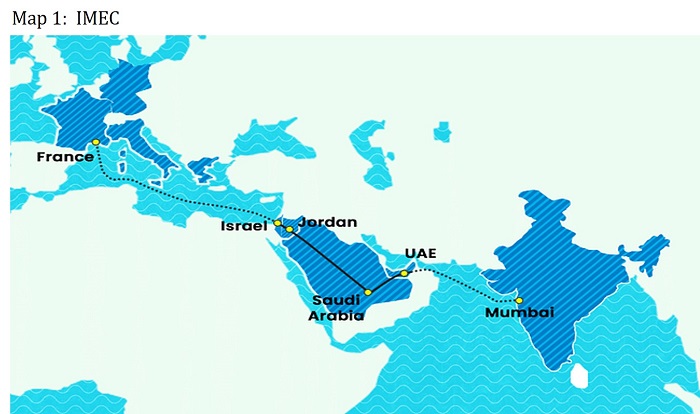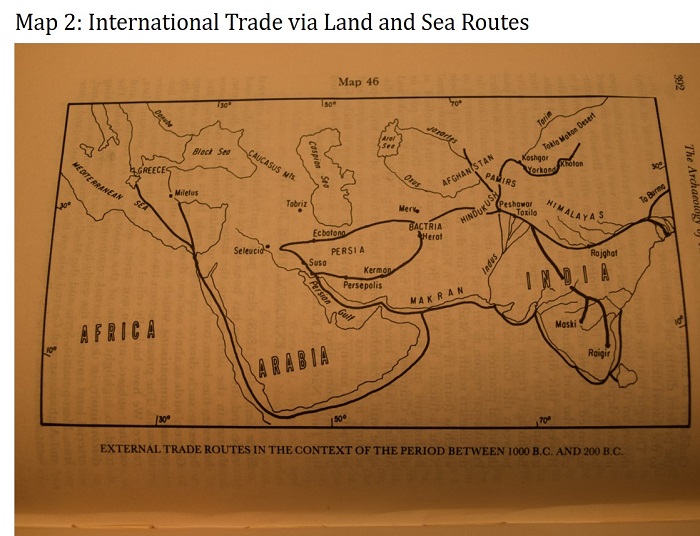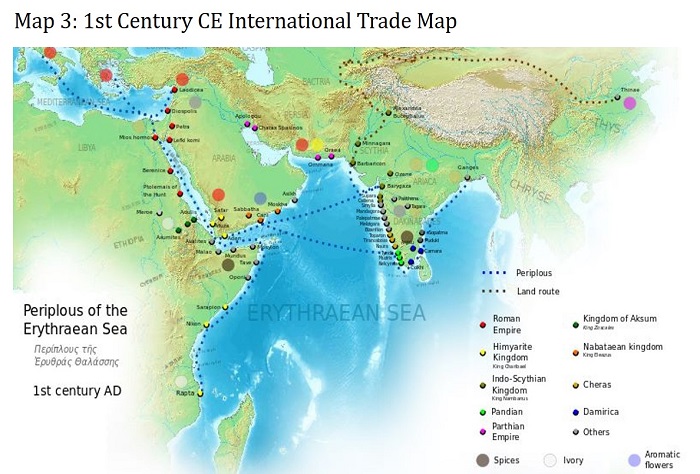Introduction
The India Middle-East Europe Economic Corridor (IMEC) which was announced at the G20 Leaders Event on the Partnership for Global Infrastructure and Investment on 9th September will have a profound global effect on the 21st century. It is being seen as a response to the failing but globally ambitious Belt and Road Initiative of China. Through this China had sought to bind countries across the world in exploitative and iniquitous infrastructure deals which have become deadly debt traps. IMEC is a strong riposte and alternative vision of global infrastructure.
The Governments of Saudi Arabia, the European Union, India, the UAE, France, Germany, Italy and the United States of America have committed to work together to establish the India - Middle East - Europe Economic Corridor (IMEC). The IMEC is expected to stimulate economic development through enhanced connectivity and economic integration between Asia, the Arabian Gulf, and Europe.
The IMEC will comprise two separate corridors, the east corridor connecting India to the Arabian Gulf and the northern corridor connecting the Arabian Gulf to Europe. It will include a railway that, upon completion, will provide a reliable and cost-effective cross-border ship-to-rail transit network to supplement existing maritime and road transport routes – enabling goods and services to transit to, from, and between India, the UAE, Saudi Arabia, Jordan, Israel, and Europe.
It is estimated that the IMEC countries (including the EU) have a combined GDP of 47 trillion dollars, around 40% of World GDP.

The White House communique reads as follows: “Through the India-Middle East-Europe Economic Corridor, we aim to usher in a new era of connectivity with a railway, linked through ports connecting Europe, the Middle East, and Asia.”
Ancient Antecedents of IMEC
In actual fact this is not new but one of the oldest trading routes on record. It goes back to Mauryan times more than 2000 years ago. It has even older antecedents. The Mauryans clashed with the Seleucids (the inheritors of the Alexandrian Greek Empire) during Chandragupta Maurya’s reign. These two powerful ancient empires met on the banks of the Kabul or Kubha River in what is now Afghanistan because of a dispute exactly over these trade routes connecting India to the Gulf and beyond.
The issue was finally resolved through a treaty, 500 elephants to the Seleucids, Chandragupta’s marriage to the daughter of Seleucus and concession of parts of modern Pakistan and Afghanistan to the Mauryans. This gave international trade a huge fillip and it increased steadily for the next thousand years. The Indian Ocean littoral was the focus of this trade.

Map 2 is a representation of the situation as it existed around 200 BCE i.e. around Mauryan times and is taken from a seminal study of ancient international trade routes by Nayanjot Lahiri [1] . Note the importance of the Gulf and Red Sea routes as a via media to Europe.

Map 3 is a representation of a navigational map based on “The Periplus Maris Erythraei” (‘Voyage around the Erythraean Sea’) which is an anonymous work from around the middle of the first century CE written by a Greek speaking Egyptian merchant. The Red Sea route and Gulf figure prominently again, as they do in the IMEC.
Both are illustrations of the great trade routes of the 1st millennium BCE and the 1st millennium CE.
Comparison of Routes
If you compare Map 1 with Maps 2 and 3 you can see the durability and seminal significance of India’s western sea route to the Gulf and then Europe. Note once more how it focuses on the Indian Ocean Littoral.
Bharat’s engagement with the world, especially the Greco Roman world was mediated through Mesopotamia, Syria and the Mediterranean.
The monsoon winds play the most important role in this. Contrary to ideas that it was Hippalus who discovered the Monsoon Winds in the 1st century CE it is clear now that they were known much before that and were taken full advantage of for the sea voyage to the Gulf and the African Coast.
Apart from archaeological evidence, there are many references in Indian literature such as the Jataka Tales and the Arthashastra. Birds were used to guide ships towards land. From the Gulf the path led towards Greece (and later, Rome) i.e. Europe. The Red Sea was a constant important link in this. It is not a coincidence that this international trade was at the base of the power and prosperity of the Mauryan Empire which stood strong on the basis of agriculture, international and internal trade and circulation of money. The fact that trade can lead to prosperity was not discovered by colonizers or neo-liberals but known well before them as is exemplified by the Mauryans and the Cholas among many other ancient empires of Bharat.
Later, it was the Cholas who intensified and furthered the trade with Southeast Asia and East Asian countries including China. What did Bharat export? Cotton, Silk and Woolen cloth, spices, wood, ivory, marble, animals, animal hides and skins, perfumes such as chandan, agaru, tailparnik, tagar, metals such as gold, silver, iron, copper, mercury, pearls, gems and jewellery. India imported and exported Chinese jade and Russian amber, too.
A complaint from the Roman natural philosopher Pliny the Elder about the drain of Roman gold into Indian coffers for luxury goods tells us of the riches pouring into India in exchange for these goods. The mummification of pharaohs and queens in ancient Egypt included ingredients imported from Bharat. It also exported and circulated ideas and stories. The Ramayana, Mahabharata, stories from the Bada Kaha, Buddhist and Jain ideas, STEM concepts and expertise, art and literature were exported far and wide. India was thus famous as a land of ideas in the international world. India was at the center of a comprehensive trade flow which started from China and Russia and ended in Europe.
The IMEC will not depend as much on Monsoon winds because of modern technology and the fact that it is a land cum sea route but has the potential to usher in a similar era of prosperity with export of goods and services as well as extension of soft power The items of import and export may have changed but the principle of trade contributing to the GDP of a country has not changed.
Trade Routes and GDP
Significantly, the EAM, Dr S. Jaishankar, in an interview with India Today spoke of these trade routes as historical, from the times of the Mauryans and their blockage after the fall of Constantinople. He also spoke of the European efforts to reach India, the center of these trade routes and the impact of these efforts on the world.
These efforts molded the world into colonies where large parts of the world were exploited economically through trade for the benefit of the colonizers.
The significance of the revival of this trade route is that it goes back to a time when the share of Bharat in World GDP was 32%, it became 4 % after the British had impoverished India i.e. the 20th century. After 1947, unfortunately, it fell further; it is now only around 3%.
The locus of world trade and economic affairs shifted from the Indian Ocean littoral to the Atlantic Ocean. Europe and North American relations defined it, although petrol interests and therefore the Gulf, remained crucial. India suffered and was sidelined. India’s contribution to world GDP, its contribution to international trade flows was in long term decline across the second millennium CE, through the Islamic invasion and drain of wealth during colonization.
The IMEC seeks to build rail infrastructure and ports to have a seamless ship to rail route for goods. Along with this will be digital networks, hydrogen pipelines and electric cables; both clean energy and communications. India can export expertise, goods and services.
Make in India is an ongoing project, Production Linked Incentives and Atma Nirbhar Bharat are being pushed by India to make itself a manufacturing powerhouse. Services export from India is one of its strengths. Ideas and implementation of Digital Public Infrastructure will be one of India’s key exports to the world. India is already an engine of global growth, IMF estimates 15% of global growth will be powered by India in 2023. Going forward, there could even be a jump in private investment needed to realize long term growth dreams and objectives.
It is being seen by some commentators as geo-political “shift”. It is not merely a shift but also a rebalancing in Asia’s favour. Can the IMEC be a harbinger to a recovery of Indian economic place in the world, can we look to a time when India contributes a third to world gross domestic product?
Only time will tell; and a serious effort to maximize our resources both human and material.
References
[1] The Archaeology of Indian Trade Routes Up to c.200 BC: Resource Use, Resource Access and Lines of Communication. Oxford University Press, 1992
(The paper is the author’s individual scholastic articulation. The author certifies that the article/paper is original in content, unpublished and it has not been submitted for publication/web upload elsewhere, and that the facts and figures quoted are duly referenced, as needed, and are believed to be correct). (The paper does not necessarily represent the organisational stance... More >>











Post new comment